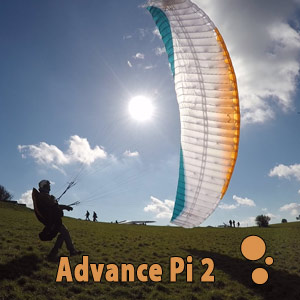
The original Pi was an astounding design but some aspects kept it limited to being mainly a mountain wing. Advance have learned from the first project and perfected the concept in the Pi 2. It is slightly lighter, slightly larger, and has much better test results - EN A for normal flying, EN B in the extended (high loading) range (size 23 and 27). The Pi suffered from being uncertified with the accelerator: the Pi 2 is a normal paraglider, with 12cm speedbar travel and 3 riser layout with split As.
.jpg)
^ Low aspect but highly photogenic
Although it's made from lighter fabrics, it feels durable and like the recent Omega XALPS, will doubtless hold up to a long life of normal use, provided care is taken on rougher terrain. It came packed in a Compressbag, which requires careful, tight folding, and the zip makes a very compressed package of the 27, which almost fills the small Pi pack 37L backpack. To use this you'll need a skimpy harness, or get a larger Comfortpack.
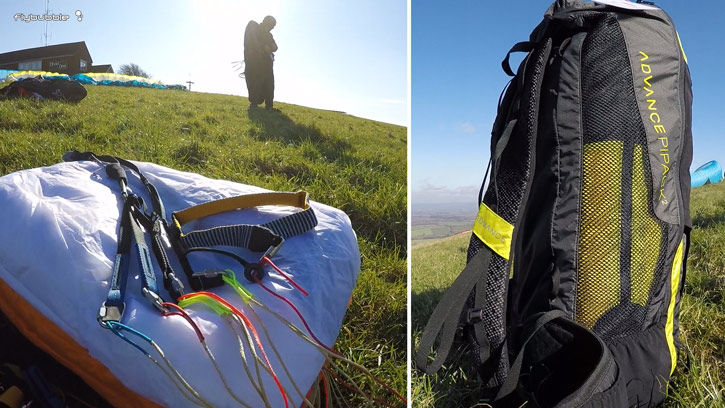
^ Yes it's a complete paraglider ... and yes it fits in that tiny bag! This is the largest size.
In light winds, the wing is a delight to control, floating up, and returning from low down without stalling or wallowing. It's very easy to get it centred overhead, even with a skew layout, and the wing waits patiently for corrective input. It has some freedom to move ahead of the pilot, so might require a dab on the brakes on steeper launches, but it resists tucking and doesn't accelerate at any point in the pullup - it is slow and predictable. At just over 3kg it is delightful when bunching and carrying the wing.
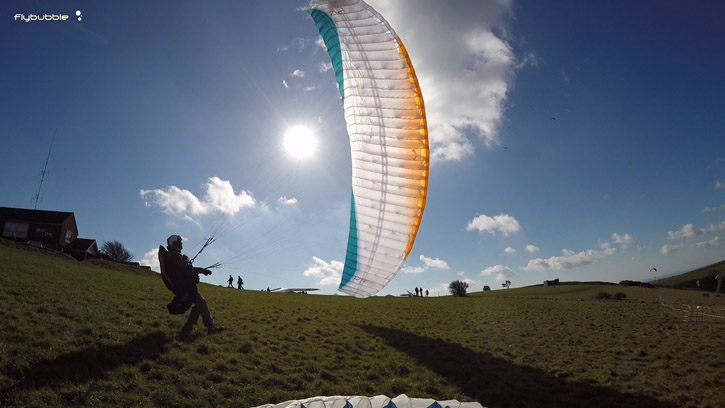
^ Interesting minimalistic internal structure
There is a down-side to having a superlight wing designed to launch effortlessly at high altitude. It can be a challenge to stop it pulling in strong wind at sea level: even with a few wraps on the brakes it dragged me upslope, and not until I'd got a grip on the C risers as well (then hauled in using all my strength) did it stay pinned. This was in strong soaring conditions when many pilots were still launching and able to control their wings on the slope. In these conditions it's hard to lay the wing out and get ready, as the featherlight fabric flutters across the ground. It's best to keep the wing parallel to the wind and lay something heavy on one tip, or launch from a bunched position.
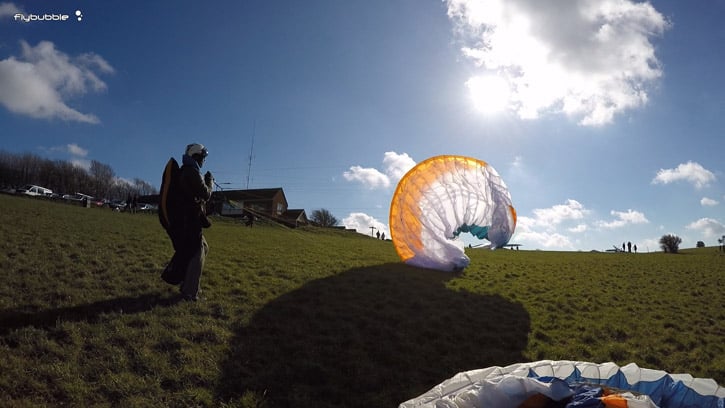
^ It's one of those wings you can just pop up from a bunched ball, without any fuss
Simply letting everything go in these conditions results in the wing launching itself, with a solid smack. It didn't pluck me off my feet, or overshoot ... it just rose up and waited. And then, I was flying.

^ So much more than a mountain wing
In the air it felt jolly, a bit like a go-kart with some suspension, zooming around, shrugging off the bumps, rustling a bit in turbulence, zipping around the corners with a low-centred balance.
The Pi 2 has massive stall resistance, you can safely hold the brakes at the seat board and it still hangs on. So you can really slow it down, great for slope landings, top landings, and 'plan b' landings.
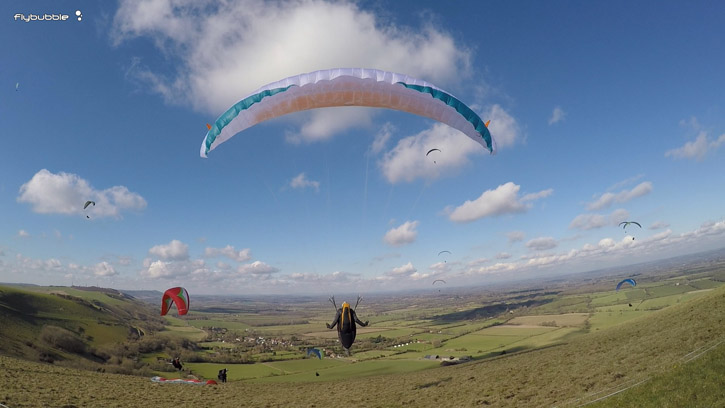
^ Massive stall resistance
The first part of the brakes are soft, and produce a gentle turn. The wing likes to stay balanced and wants to 'return to centre' unless you weight shift into the turn, so it's important to fly with a harness with good weight shift freedom. I found the best thermaling turn was with about 40% brake on the inside only, where the soft brake pressure becomes moderate.
The low aspect wing really turns on a dime, so you'll probably find yourself able to turn right into the core of the thermal, sometimes inside other pilots. This, combined with an impressive lifty aerofoil, means your climb rate will be excellent. (Remember that I'm reviewing this at light loading). Putting in too much brake in the turn hooks into a spiral, but the energy is limited and the exit immediate.
It is stable in pitch, roll and yaw. I failed to produce any significant pitch/dive movements, mainly due to the wing not dropping back beyond a certain limit. Any forward surge is therefore limited, and quickly absorbed, resulting in a steady ride for the pilot. I failed to produce any significant wingover too, as the wing absorbed my attempts to get the tips below the horizon. It doesn't have any tendency to 'dig in' on the turns.
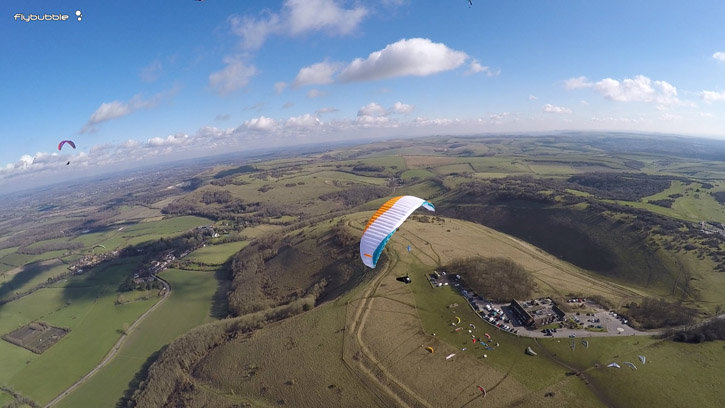
^ At light loading, it's easy to stick with the gaggle during climbs
This simplicity is probably very welcome when you're flying from some monstrous mountain dangling in an ultralight harness with climbing gear over your shoulders. For general flying, it is probably more stable than you need it to be, but it's by no means a dull ride. You have to deliberately guide it around: if left alone it feels as if it's connected to some hidden stabilizer.
Where it really surprised me was in the way it performed. You look up and think "how is it doing this?" I was thermaling with the pack, outclimbing those who weren't paying attention, and giving the high-class wings a bit of a bother. Gliding at trim speed seemed similar to the odd assortment of wings I saw nearby, and that was at my loading. I didn't feel as if I was losing out on glide. Go closer to the 105kg 'freeflying' limit and you'll be one of the fastest wings at trim. Bulk up to the 120kg extended weight range and you'll be flying a speedwing, but one with grin-inducing glide.
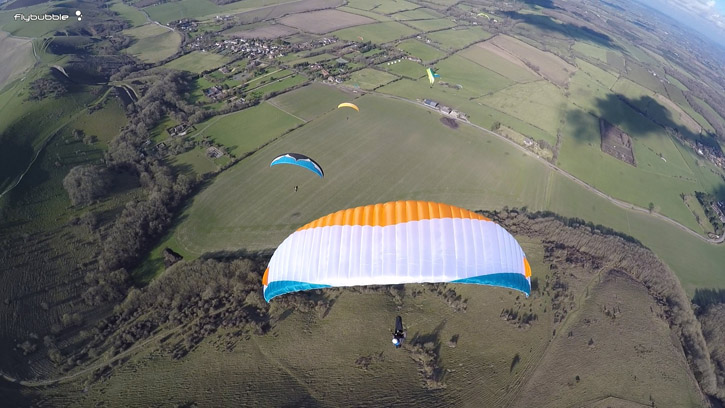
^ It's only when you have a long into-wind glide on full bar that you might feel a bit of a step to the higher classes of wings
After thermaling up to the clouds rather quicker than I'd expected to, I found myself a long way downwind of the site, so stomped on the speedbar for a 10 minute return glide against a strong headwind. This is where you'll miss the extra penetration of a higher class glider. In my rough analysis of the GPS I could only get around 7km/h increase (in cold conditions at low loading and low altitude). Whatever it really is, acceleration is not the Pi 2's strong point, but it's a useful increase in speed that still retains glide angle, easily enough for cross country flying.
Big ears were simple, stable and effective. Asymmetric collapses were uneventful, with an ordinary turn and self-reinflation. There was no spin tendency or other surprises.
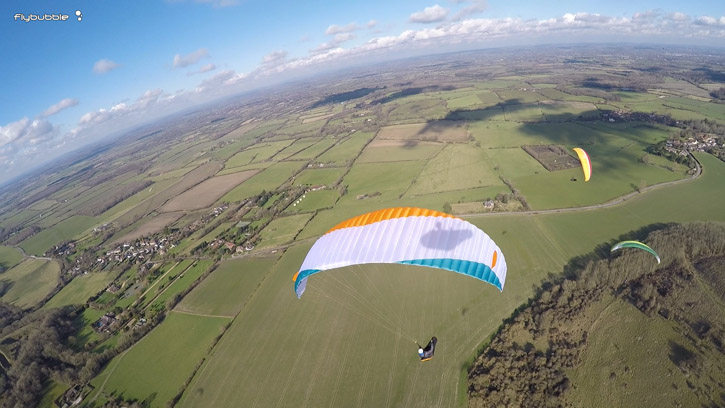
^ Shadow play with the cameraman
Summary
If you're looking for a travel wing that won't limit your flying options but packs into your cabin luggage, the Pi 2 is an outstanding choice. If you like the idea of hike-and-fly it will open up the tougher routes and high-altitude cliff hucks, with its bomb-proof launch and balanced handling. But you might be able to skip the serious mountaineering altogether, because you've got all the performance you need to fly there instead. Thermal, glide, explore, and don't care about walkouts anymore. The Pi 2 is accessible to all pilots, from students to skydogs, there are no surprises with this wing and it's pleasing to fly.
Technical info
PI 2 27 (75-105 / 120) flown at 84kg
HARNESS FLOWN: Skywalk Range XALPS
TEST CONDITIONS: 2 hours in spring conditions, 2m/s thermals up to 2500ft, 10 degrees C, basewind 20km/h
TEST PILOT: instructor with over 2500 hours, over 150 wings reviewed, flying since 1992. Currently flying Omega XALPS.
Find out more about the Advance PI 2 >
Advance Pi 2 Review (Flybubble Phil)
The glider has a choice of sizes and behaviours depending on your loading: I could have flown the Size 16 to have something like a speed wing or the Size 19 with an EN C behaviour. As it happens I flew the Pi 2 27 (EN A 75-105kg) at 90kg .
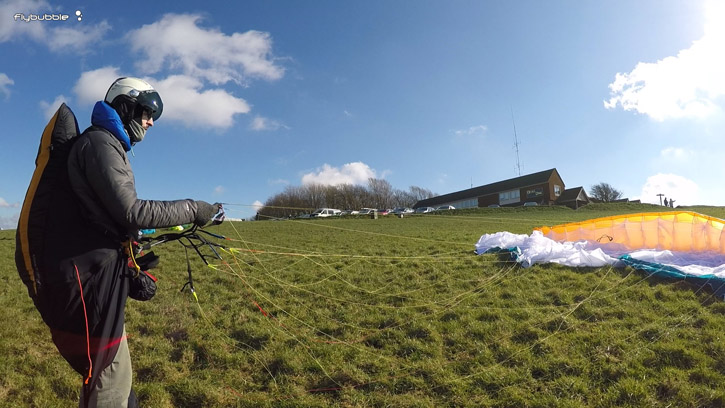
^ If there's some wind, the wing won't stay on the ground for long...
The very first impression is that it’s very light, it's a huge glider but weighs what feels like nothing, looking at it from just out of the compress bag it's a tiny block of nylon. The risers are skinny but standard weight with maillons, there are two A lines per side on the main risers and they have blue ends, the 'big ear' A riser has a red ended line and there's a nice obvious chunk of blue on both the A risers. There's only a short distance between the pulleys for the speed bar and no kick down so it's all at 3:1, you'll still need two steps or long legs to get full bar.
Apart from the coloured sheath on the line where it meets the maillon, the rest of the main line set is unsheathed and with three rows and one upper cascade (with a little pyramid of lines coming off of the centre C's) there's not much to untangle. There are sensible magnetic retainers for the brakes that have a plastic moulded fitting that makes them clunk into place nicely on the riser. The ceramic rings for the sheathed brake lines to run through are quite small and there's also swivels on the brake handles. The cloth itself is thin but it doesn't feel particularly fragile and it's a nice mix of colour, the white really shows of the internal structure in the sun.
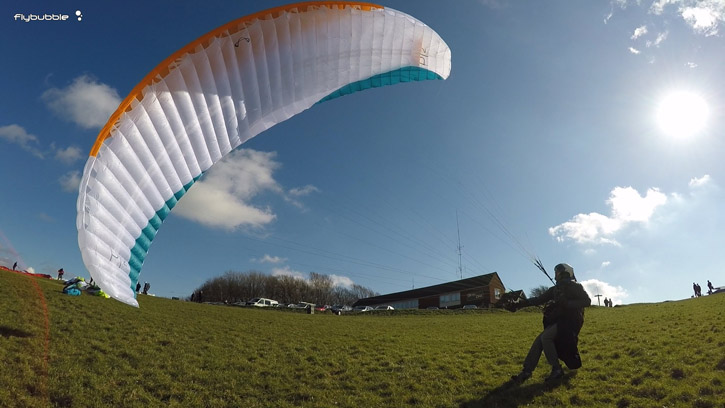
^ Simple ground handling
Once clipped in no real pull is needed to bring the glider up, you have to be really heavy handed to provoke any nonsense. Even off line and from a heap it's one of the easiest wings to kite, it's default position is above your head and it really tries to get back there from wherever you put it. Those big openings make forward launching a doddle.
On the ground there's a massive range of brake travel, up in the air the brakes were light and the weight shift response and general behaviour reminded me of the Alpha 5 that I had a brief float on last summer.

^ Steady, balanced turns
Trim speed seemed much the same as any other regular EN B that was in the air today and my impressions were that it climbed just as well in the weak thermals as the regular pilots on regular gliders. I certainly didn't feel hindered by it but I didn't feel any great advantage either. It turns really quite tightly without banking up much so maybe I was just twisting it up on the inside?

^ You must lean in hard to keep the Advance Pi 2 in a banked turn, or it will flatten out
After the first climb I hooked up the speed bar and I got to play with it a fair bit. I found that it was smooth and easy to push and easy to hold with a noticeable increase in speed, maybe 10 to 12 kph? C risers worked well to make small course corrections.
At the other end of the speed range there's oodles of brake and it's easy to slow down for landing. There's not huge amounts of energy for wagga freestyle moves, I limited my exuberance to some mild wing-unders and beyond the big ears for the video I didn't pull any big collapses. After all, this is kit that needs to be looked after, it's not mine and I'm fairly certain there's no nasty surprises lurking.

^ Playing with pitch control. That's about as far back as you can get the wing to pitch.
I didn't pack it but Greg managed to get it back in the bag with no fuss, the leading edges rods aren't all that thick and whilst there's lots of bits on the inside they are cut so that there's absolutely nothing more inside than what's necessary to do the job of spreading the loads.
Summary
Simple, well-made and lots of structure but you get the feeling it's put together with precision and finesse. Pretty much what you'd expect from Advance. It needs some care but in the right hands it's a very capable wing and at this loading it'd be perfect for those looking to downsize the weight or spice.
Technical info
- PI 2 27 (75-105kg EN A / 105-120kg EN B) flown at 90kg.
- HARNESS FLOWN: Advance Lightness
- TEST CONDITIONS: 1 hour in spring conditions, 2m/s thermals up to 2500ft, 10 degrees C, basewind 20km/h
- TEST PILOT: Chief coach, over 900 hours, flying since 1989. Currently flying Advance Omega 8.
Find out more about the Advance Pi 2 >
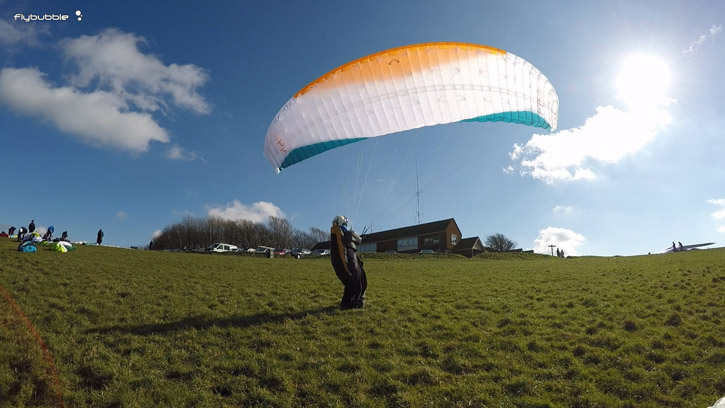
Phil Clark took the smaller Pi 23 (65-95kg) out to Bo Peep yesterday in very light and scratchy conditions.
Phil: "At 90kgs I'm still in the EN A range on the next size down (the 23) but you do notice the smaller size, it's more responsive on the ground and it feels a little hotter in the air. There's more response in the harness to the little bumps in the air and the brakes are still long, it comes around quicker in the turn but you feel the loss of energy more. The larger size would float and come around nicely in weak lift but this either turns too wide or whips round and drops you a few feet as it does so.
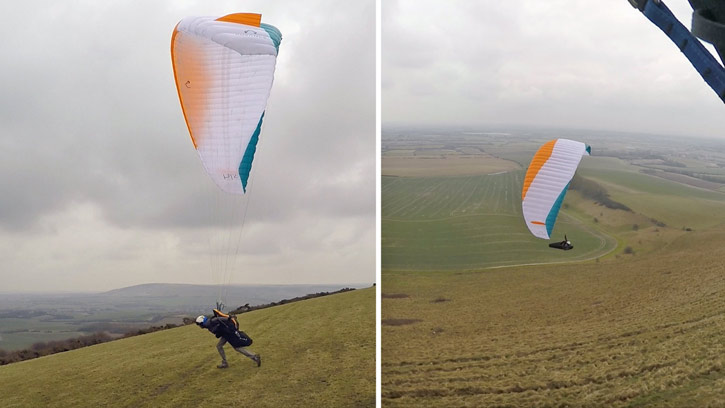
In the light conditions a steady beat would see me eek back what I lost in the last turn but I couldn't quite get it to climb as well as the 27 in the weak patches. Perhaps not surprisingly it is a step quicker in trim speed but that speed is at the expense of the sink rate. Not by much, but enough to make a difference on a marginal (weak lift) day. I'd like to try the 23 on a soarable day with some thermals but my favourite so far would be the larger one (27)."
That's for ordinary hill flying. The success of the Pi 2 and the size you choose is largely down to what kind of flying you intend to do with it.
Find out more about the Advance PI 2 >
Advance Pi 2 paraglider review video
Brought to you by Flybubble
Like what we do? The best way to thank and support us is to buy gear from us and recommend us to others. Review our service on Trustpilot and our products on Flybubble Shop. You can also subscribe to Flybubble Patreon. Thank you!

